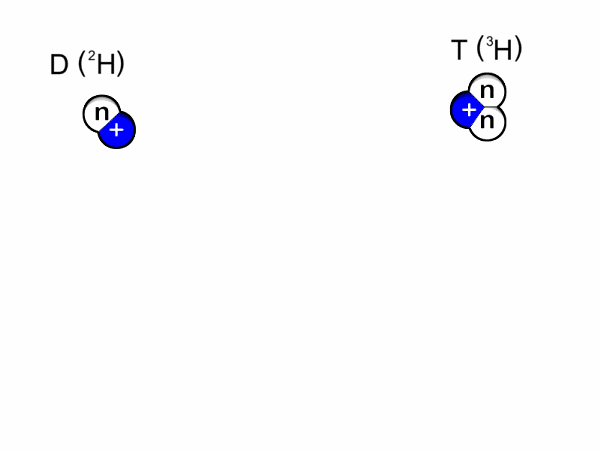Nuclear fusion

Nuclear fusion is a type of nuclear reaction where two light nuclei collide together to form a single, heavier nucleus. The products of this reaction are generally unstable compound nuclei, and thus they decay into more stable daughter products. This fusion results in a release of energy because the mass of the new nucleus is less than the sum of the original masses. Based on the principle of mass-energy equivalence, this mass difference means that some mass has been converted into energy.[2] For elements lighter than iron, fusion yields energy. For elements heavier than iron, it is instead a process of fission that results in a yield of energy.
Although there is a large yield in energy from the nuclear fusion process, there are forces that must be overcome to initiate this process. A lot of energy is required to overcome the Coulomb repulsion that exists between the protons in the nuclei that are being pushed together. As well, the hydrogen atoms must be pushed close enough together so that the strong nuclear force can begin to act, but this requires a very small separation. This is part of what makes controlled fusion difficult to achieve.[2]
Types of Fusion Reactions
There are several different types of fusion reactions, but most involve two isotopes of hydrogen known as deuterium and tritium. Some fusion reactions include:[3]
- Proton-proton chain: This type of fusion reaction is the one that takes place in the Sun. Here two pairs of protons collide and become two atoms of deuterium. Each deuterium them combines again with a proton to form helium-3, which combine again and eventually form helium-4.
- Deuterium-deuterium reactions: Here two deuterium atoms combine to form helium-3 and a neutron.
- Deuterium-trituim reactions: Here one atom of deuterium combines with one atom of tritium to form helium-4 and a neutron. Most of the energy released here is in the form of a high-energy neutron. This process is shown in Figure 1 and an animation is shown in Figure 2.

Use in Energy Generation
There currently exists no large-scale fusion reactor that could provide energy for use. This is because it has been difficult for scientists to create a controllable, non-destructive way of harnessing the energy released during fusion.[3] The process of fusion is difficult to control largely because of the extreme conditions necessary for the reactions to take place.
First, fusion requires both extremely high temperatures to give hydrogen atoms enough energy to overcome repulsion between the protons. Energy from microwaves or lasers must be used to heat hydrogen atoms to the necessary temperatures. At these temperatures, hydrogen is a plasma, and this plasma must be sufficiently contained for fusion to continue as well as for safety.[3] Second, high pressures are needed to squeeze hydrogen atoms close enough to fuse. Again, this is done by using intense magnetic fields, lasers, or ion beams.[3]
For potential nuclear energy sources, the deuterium-tritium fusion reaction is most likely simply because the conditions are less extreme.[2]
Currently, the largest fusion effort is the International Thermonuclear Experimental Reactor or ITER in France. This reactor began construction in 2013 and uses a confiment method known as a Tokamak. This Tokamak provides a way to magnetically confine the hot plasma required for fusion. The experimental phase of ITER is expected to begin in 2027.[5] For more information on this project, click here.
References
- ↑ Wikimedia Commons. (August 4, 2015). Nuclear Fusion [Online]. Available: https://upload.wikimedia.org/wikipedia/commons/thumb/3/3b/Deuterium-tritium_fusion.svg/2000px-Deuterium-tritium_fusion.svg.png
- ↑ 2.0 2.1 2.2 HyperPhysics. (August 4, 2015). Nuclear Fusiom [Online]. Available: http://hyperphysics.phy-astr.gsu.edu/hbase/nucene/fusion.html
- ↑ 3.0 3.1 3.2 3.3 Craig Freudenrich. (August 4, 2015). Physics of Nuclear Fusion Reactions [Online]. Available: http://science.howstuffworks.com/fusion-reactor1.htm
- ↑ Wikimedia Commons. (July 31, 2015). Animated D-T Fusion [Online]. Available: https://commons.wikimedia.org/wiki/File:Animated_D-T_fusion.gif#/media/File:Animated_D-T_fusion.gif
- ↑ ITER. (August 4, 2015). ITER - the way to new energy [Online]. Available: https://www.iter.org/

